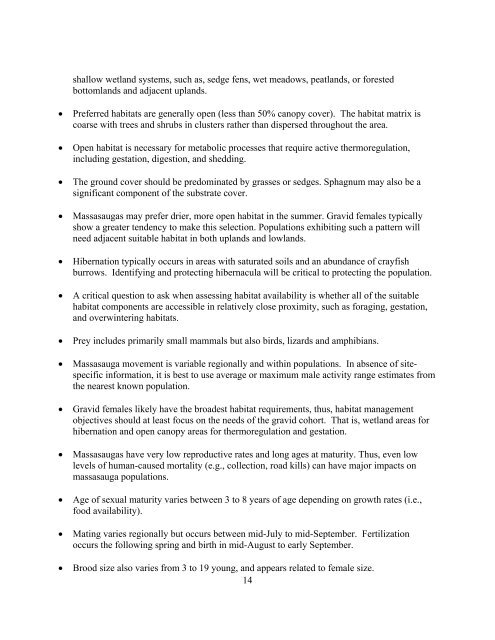The Eastern Massasauga Rattlesnake: - U.S. Fish and Wildlife Service
The Eastern Massasauga Rattlesnake: - U.S. Fish and Wildlife Service
The Eastern Massasauga Rattlesnake: - U.S. Fish and Wildlife Service
Create successful ePaper yourself
Turn your PDF publications into a flip-book with our unique Google optimized e-Paper software.
shallow wetl<strong>and</strong> systems, such as, sedge fens, wet meadows, peatl<strong>and</strong>s, or forested<br />
bottoml<strong>and</strong>s <strong>and</strong> adjacent upl<strong>and</strong>s.<br />
• Preferred habitats are generally open (less than 50% canopy cover). <strong>The</strong> habitat matrix is<br />
coarse with trees <strong>and</strong> shrubs in clusters rather than dispersed throughout the area.<br />
• Open habitat is necessary for metabolic processes that require active thermoregulation,<br />
including gestation, digestion, <strong>and</strong> shedding.<br />
• <strong>The</strong> ground cover should be predominated by grasses or sedges. Sphagnum may also be a<br />
significant component of the substrate cover.<br />
• <strong>Massasauga</strong>s may prefer drier, more open habitat in the summer. Gravid females typically<br />
show a greater tendency to make this selection. Populations exhibiting such a pattern will<br />
need adjacent suitable habitat in both upl<strong>and</strong>s <strong>and</strong> lowl<strong>and</strong>s.<br />
• Hibernation typically occurs in areas with saturated soils <strong>and</strong> an abundance of crayfish<br />
burrows. Identifying <strong>and</strong> protecting hibernacula will be critical to protecting the population.<br />
• A critical question to ask when assessing habitat availability is whether all of the suitable<br />
habitat components are accessible in relatively close proximity, such as foraging, gestation,<br />
<strong>and</strong> overwintering habitats.<br />
• Prey includes primarily small mammals but also birds, lizards <strong>and</strong> amphibians.<br />
• <strong>Massasauga</strong> movement is variable regionally <strong>and</strong> within populations. In absence of sitespecific<br />
information, it is best to use average or maximum male activity range estimates from<br />
the nearest known population.<br />
• Gravid females likely have the broadest habitat requirements, thus, habitat management<br />
objectives should at least focus on the needs of the gravid cohort. That is, wetl<strong>and</strong> areas for<br />
hibernation <strong>and</strong> open canopy areas for thermoregulation <strong>and</strong> gestation.<br />
• <strong>Massasauga</strong>s have very low reproductive rates <strong>and</strong> long ages at maturity. Thus, even low<br />
levels of human-caused mortality (e.g., collection, road kills) can have major impacts on<br />
massasauga populations.<br />
• Age of sexual maturity varies between 3 to 8 years of age depending on growth rates (i.e.,<br />
food availability).<br />
• Mating varies regionally but occurs between mid-July to mid-September. Fertilization<br />
occurs the following spring <strong>and</strong> birth in mid-August to early September.<br />
• Brood size also varies from 3 to 19 young, <strong>and</strong> appears related to female size.<br />
14

















